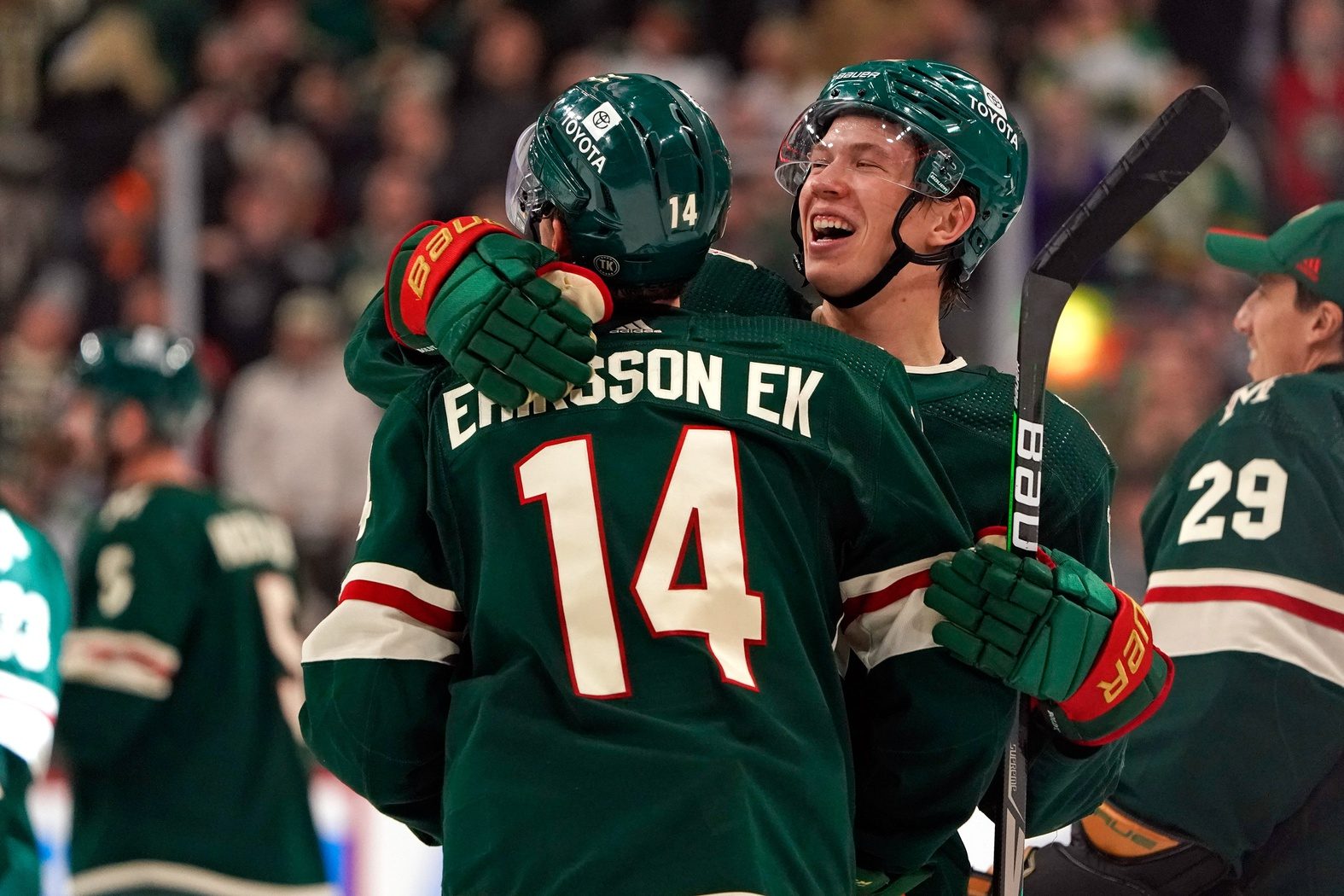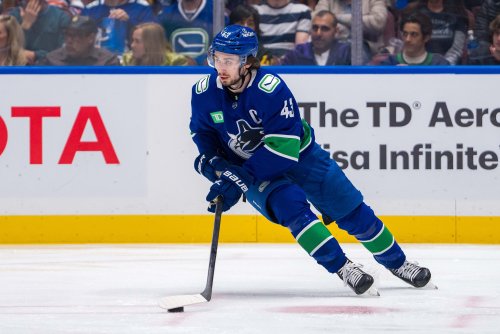
For the past two seasons, Dean Evason's Minnesota Wild were defined by two things: balance and depth. Evason spread the talent between the Top-9 while reserving enough to roll a credible fourth line. For the most part, this suited the team fantastically. Only the Florida Panthers, Colorado Avalanche, Toronto Maple Leafs, and Carolina Hurricanes had more points over the past two seasons.
Those lines, which stayed intact from about January to the end of the regular season last year, barring injuries, were designed to get scoring from multiple lines. It worked in the regular season. Each of the Wild's three scoring lines scored 65% or more of the goals at 5-on-5. Only the Boston Bruins and Hurricanes matched them.
It's hard to argue with that success. Except to say, in the playoffs, the Wild's lines suffered a major power outage in both seasons. Kirill Kaprizov's line broke through last year, but as for everyone else? Joel Eriksson Ek couldn't carry his line alone, and Matt Boldy and Kevin Fiala got cold at the worst time.
Is it time for a new approach?
Balancing the lineup made sense in those two seasons because the Wild essentially had to do it. Yes, they were deep along the wing, but their center situation necessitated a by-committee approach. So if Kaprizov and Fiala could maximize Ryan Hartman and Freddy Gaudreau into looking like Top-6 centers, why not let them?
But we're flipping the calendar to the 2022-23 season. There's no more Fiala to elevate someone like a Gaudreau. And finally, there may no longer need to be a center-by-committee approach.
Marco Rossi is finally ready for prime time, and he brings a much-needed dynamic element to the center position for Minnesota. Eriksson Ek spent the last two years answering the question What if Mikko Koivu could score goals? The results are, He'd be Eriksson Ek, who is damn good.
So why make a lineup like they did when Minnesota didn't have two Top-6 centers? The Wild can load up their top two lines and set them loose on the NHL.
What do those two lines look like? Let's go with this early thought:
Kaprizov - Rossi - Mats Zuccarello
Boldy - Eriksson Ek - Hartman
With both those lines, Evason could take what their stars do well and enhance them with more star power. Rossi is pretty similar to Kaprizov, a strong forward who's a beast in transition, challenging to knock off the puck despite his shorter stature, and gritty enough to go to the net.
With Rossi, Kaprizov gets a center with more raw skill and better defensive capabilities at the pivot. Hartman performed admirably at the center, but all he did was drive offense, essentially. Rossi's ability to be a puck hound and turn the play from defense to offense will ensure Kaprizov gets more time in the offensive zone.
It seems like a lot to ask Rossi to step in as a top-line center, but at the same time, not really. Look, Victor Rask had success between Kaprizov and Zuccarello. It's as foolproof as a place in the lineup to find success. There's no scenario possible where Rossi will be the focus of opposing defenses, either.
As for Eriksson Ek, you can give him a similar role but a lot more skill to do it with. Eriksson Ek loves to do two things: get to the net in the offensive zone, and clear the net in the defensive zone. With Marcus Foligno and Jordan Greenway, that translated to the best defensive line in hockey, with a tendency to pick up goals by crashing the net.
Their size and skill made for a formidable challenge for opponents, and we keep that element for Eriksson Ek here. Matt Boldy is 6'2" and 201 pounds with impossibly gifted hands. He can dance through traffic, hold onto the puck, and both shoot and thread impossible passes. All due respect to Foligno and Greenway, who are talented in their own right, but Eriksson Ek's never had a linemate like this.
This arrangement can create oodles of rebound chances for Eriksson Ek at the net. Eriksson Ek wreaking havoc in the crease, along with Boldy's abilities, should also find space for Hartman to do what he does best: Get open and pick a corner. This time, though, he'll have much less defensive responsibility at the wing.
Plus, all three have great two-way acumen. Boldy immediately drove play as a rookie, Eriksson Ek is arguably the best defensive center in the game, and Hartman can drive defense when not asked to be a center. Maybe Boldy isn't as hit-happy as the other two, but they're all physically imposing.
Then Evason has a wealth of options to fill out the bottom lines. Can Gaudreau join Greenway and Foligno to carry the puck to the offensive zone, then let the two big guys grind opponents to dust? Connor Dewar, Tyson Jost, Sam Steel, Brandon Duhaime, and Sammy Walker offer the ability to prioritize speed and/or defense on the fourth line.
These lines might not be as balanced as they were last year, but that's not a bad thing. If Rossi is everything we at 10K Rinks think he is -- and his pedigree suggests so -- then the Wild have a 1-2 punch at center few teams can match.
Sure, Florida has Sasha Barkov, Sam Bennett, and Anton Lundell, the Leafs have Auston Matthews and John Tavares, and the Tampa Bay Lightning have Brayden Point and Anthony Cirelli. Who cares? They're all out east.
What about the Western Conference? Obviously, Connor McDavid and Leon Draisaitl will blow anyone else out of the water. Who else, though?
Assuming Rossi hits the ground running, there are really only three other candidates. The Calgary Flames have Nazem Kadri and Elias Lindholm. Those two have questions, though. Kadri had a career year at 31 with a loaded Avs team. Lindholm was brilliant next to Johnny Gaudreau, an MVP-caliber player. Can he repeat that on a second line with Andrew Mangiapane?
Anze Kopitar and Phillip Danault of the Los Angeles Kings offer two great two-way forwards at the top of the lineup. Kopitar is up there in age, though, having turned 35 in August. Can he be Joe Thornton? Sure, especially riding shotgun with Fiala over Dustin Brown. But he could also start fading. There are no guarantees at 35.
So that leaves the St. Louis Blues with Robert Thomas and Ryan O'Reilly. That duo mirrors the Rossi/Eriksson Ek dynamic Minnesota is hoping for here. Thomas helms the offensive line, enabling Vladimir Tarasenko and Pavel Buchnevich to run wild. O'Reilly buttons it down defensively and scores clutch goals, as he did several times against the Wild last postseason.
But even elite on-paper teams like Colorado can't match that punch anymore. After losing Kadri, they've got Nathan MacKinnon and Alex Newhook, who scored a respectable 33 points for the Avs as a rookie. Can they count on him to be Kadri after losing Kadri's running mate, Andre Burakovsky as well?
The Dallas Stars have Joe Pavelski, then an old, hurt Tyler Seguin. Nashville has Ryan Johansen and Mikael Granlund, two 30-year-olds who are good but rarely dominant. The Anaheim Ducks and Vegas Golden Knights have Trevor Zegras and Jack Eichel, but Ryan Strome and William Karlsson aren't making noise behind them. The San Jose Sharks might have Tomas Hertl and Logan Couture, but they are bad just about everywhere else.
The Wild's success in such an arrangement would rely heavily on Rossi's readiness. But the season was going to do that anyway. A balanced roster couldn't break through two first-round matchups, much less Colorado. Loading up the top line might be the only way for Minnesota to get the edge on paper, and on the ice, against the heavyweights of the NHL.
Think you could write a story like this? Hockey Wilderness wants you to develop your voice, find an audience, and we'll pay you to do it. Just fill out this form.






Recommended Comments
There are no comments to display.
Join the conversation
You can post now and register later. If you have an account, sign in now to post with your account.
Note: Your post will require moderator approval before it will be visible.